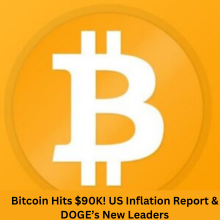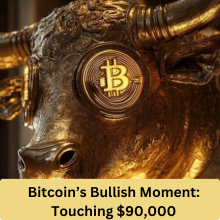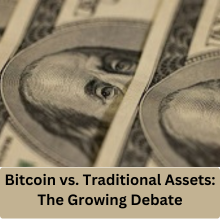In the world of global finance, November 2024 is shaping up to be a month of volatility, with key developments making waves in both traditional and digital markets. From Wall Street taking a breather after its post-election surge, to Bitcoin’s eye-popping rise to $90,000, this edition of World Street dives deep into the factors affecting markets worldwide. Let’s explore these significant movements and what they mean for investors and traders alike.
Wall Street Takes a Breather After Election Rally
Following the US presidential election on November 6, Wall Street experienced a massive rally, driven by investor optimism. However, as expected, the market is now in a consolidation phase, taking a slight breather.. On November 12, major indices posted declines: the Dow Jones Industrial Average dropped by 0.9%, the S&P 500 fell by 0.3%, and the Nasdaq Composite edged down by 0.1%.
Key Data to Watch: US Inflation and Consumer Price Index (CPI)
Investors are now shifting their focus to upcoming economic data, particularly the US Consumer Price Index (CPI) report set to be released on November 13. The CPI is a crucial indicator of inflation, reflecting the cost of goods and services. Economists expect October’s CPI to show a 0.2% rise, which would bring the annual inflation rate to 2.6%. This data is critical for the Federal Reserve’s decision-making process on interest rates, and it could potentially influence market sentiment in the coming days.
Impact of the CPI report on market sentiment
The CPI report will be closely scrutinized by investors. If inflation continues to rise, it may signal a need for the Federal Reserve to act more aggressively on interest rates. On the other hand, a lower-than-expected CPI could support the case for a more dovish stance from the Fed, helping to boost investor confidence. Either way, the market will be reacting to the data, with implications for both equity and cryptocurrency markets.
Bitcoin’s Bullish Moment: Touching $90,000
Bitcoin has made headlines in recent days, surging to new heights. On November 12, it briefly touched the $90,000 mark, marking a dramatic increase of over $20,000 since the beginning of November. This rise has led many to wonder what’s driving Bitcoin’s bullish momentum.
Bitcoin Surges Ahead: What’s Behind the $90,000 Mark?
Bitcoin’s price rally can be attributed to several factors, including increased institutional adoption and a general market sentiment that is bullish on digital assets. Moreover, Bitcoin’s performance often moves in response to traditional market conditions, such as inflation data and US Federal Reserve policy. In the case of this recent surge, Bitcoin seems to be benefiting from the market’s reaction to both post-election optimism and growing concerns about inflation.
Bitcoin’s Price Movements Post-Election: A Whirlwind Week
The cryptocurrency market has been volatile in the days following the US election. After Donald Trump’s victory on November 6, the total cryptocurrency market capitalization soared from $2.2 trillion to $3 trillion before settling at around $2.8 trillion. Bitcoin, as the largest cryptocurrency by market cap, benefited most from this surge, reflecting both growing demand and speculative trading activity.
Bitcoin’s Rise Amid US Inflation and Market Volatility
Bitcoin’s recent rise is closely linked to the ongoing concerns about inflation in the US. As the CPI report approaches, there is a sense that inflation might continue to exert pressure on traditional fiat currencies, driving investors toward Bitcoin as a store of value. Bitcoin’s decentralized nature and finite supply have made it an appealing hedge against inflation, similar to gold.
The Role of Market Liquidity in Bitcoin’s Price Action
Another key factor driving Bitcoin’s price movement is liquidity. As more institutional investors and retail traders engage with Bitcoin, its liquidity has improved, enabling more dramatic price swings. This liquidity plays a crucial role in enabling Bitcoin to reach new price levels, but it also makes the asset more susceptible to volatility.
Asia-Pacific Markets: A Slowdown After US Election Rally
While Wall Street enjoyed a post-election surge, markets in the Asia-Pacific region have taken a different trajectory. Most major stock indices in the region opened lower on November 13, reflecting Wall Street’s losses.
Japan’s producer price index (PPI) hits new high
In Japan, October’s year-on-year Producer Price Index (PPI) growth reached 3.4%, the highest level since July 2023. This suggests that inflationary pressures are building in the Japanese economy, which could affect corporate profits and economic growth. As a result, Japan’s Nikkei 225 index dropped by 0.5%, and the Topix fell by 0.3%.
South Korea and Australia Experience Market Declines
South Korea’s Kospi index dropped 1.1%, while the Kosdaq declined by 1.4%. In Australia, the S&P/ASX 200 fell by 1.4%, reflecting the broader market weakness. The slowdown in Asia-Pacific markets can be partly attributed to global concerns about inflation and the potential for tighter monetary policy in the US.
US Inflation Report: What’s at Stake for Investors?
As the US CPI report looms, investors are on edge. The data could influence not just the US stock market but also global asset prices, including Bitcoin.
Understanding the Consumer Price Index (CPI)
The CPI measures the change in the prices of a basket of goods and services, offering a snapshot of inflation. A higher-than-expected CPI would indicate rising costs for consumers, which could prompt the Federal Reserve to tighten monetary policy further.
Core Inflation vs. Headline Inflation: The Real Concerns
Core inflation, which excludes volatile items like food and energy, is a key measure that investors watch closely. While headline inflation is expected to increase to 2.6% year-on-year, core inflation has also seen a recent uptick, suggesting that inflationary pressures may be more persistent than initially expected.
Market Reaction to the October CPI Release
The market will likely react strongly to the CPI data, especially if inflation is higher than expected. Higher inflation could lead to increased volatility in both traditional and digital markets. Conversely, a softer CPI reading might signal a more dovish approach from the Federal Reserve, which could buoy investor sentiment.
What to Expect from US Treasury Yields and Fed Decisions
US Treasury yields have already been climbing, reflecting expectations of tighter monetary policy. The yield on the US 10-year Treasury note has surged from 3.6% to 4.4% since the Federal Reserve’s rate-cutting cycle began in September. This suggests that the market is pricing in slower interest rate cuts and a potentially prolonged period of higher rates.
The Power Shift in Dogecoin (DOGE) Leadership
In the world of cryptocurrency, Dogecoin (DOGE) has seen a leadership shift, with two major figures at the helm.
Ramaswamy and Musk: The New Leaders of DOGE
Vivek Ramaswamy, the biotech entrepreneur and political figure, and Elon Musk, the CEO of Tesla and SpaceX, are now taking charge of DOGE. Both are vocal supporters of the meme coin, and their influence is helping to shape its future.
How Elon Musk’s Influence Continues to Shape DOGE’s Future
Elon Musk’s tweets and public support have long been a driving force behind Dogecoin’s price fluctuations. As Musk continues to promote DOGE, it remains a major player in the cryptocurrency space, despite its origins as a joke coin.
Also read: $361M Mega Millions Jackpot: Ohio’s Big Winners Revealed
The Role of Political Figures in the Crypto Market
Ramaswamy’s involvement in DOGE adds an interesting political dimension to the story. As a vocal advocate for cryptocurrencies, his leadership could influence DOGE’s future in ways that go beyond market speculation and into the realm of policy and regulation.
Bitcoin vs. Traditional Assets: The Growing Debate
Bitcoin’s growing adoption has sparked debates about its role compared to traditional assets like gold, stocks, and bonds.
Comparing Bitcoin’s Performance with Gold and Other Commodities
Bitcoin is often referred to as “digital gold,” and with good reason. Like gold, Bitcoin is seen as a hedge against inflation. Over the past year, Bitcoin’s price movements have mirrored some of gold’s traditional safe-haven appeal, making it an attractive option for investors looking to diversify their portfolios.
Bitcoin’s Role in the Broader Financial Ecosystem
Bitcoin’s role as a non-correlated asset makes it an appealing option for investors looking to hedge against market uncertainty. As more institutional investors enter the space, Bitcoin’s place in the broader financial ecosystem continues to grow.
Volatility in the Crypto Market: A Look Ahead
Cryptocurrency markets, including Bitcoin, are known for their volatility. This volatility can present both opportunities and risks for investors.
Understanding Implied Volatility in the Crypto Market
Implied volatility reflects the market’s expectations of future price swings. Bitcoin’s implied volatility has surged, reaching levels as high as 90%, as the cryptocurrency market braces for potential price swings following the US inflation report.
How Bitcoin’s Price Fluctuations Affect Investor Sentiment
Price fluctuations in Bitcoin can cause major shifts in market sentiment. Investors are often caught between the potential for high returns and the risk of significant losses. As the market becomes more volatile, investor sentiment will likely become even more sensitive to news events and data releases.
Market Outlook: What to Expect Next Week
Looking ahead, there are several key events that could influence market movements in the coming week.
US Inflation Data and Its Impact on Bitcoin and Traditional Markets
The release of the CPI report will be a major event to watch. If inflation continues to rise, it could lead to a sell-off in traditional markets, while boosting Bitcoin’s appeal as a store of value.
Emerging Trends in Asia-Pacific Markets
The Asia-Pacific region may face further challenges as inflationary pressures build, potentially affecting the outlook for both local markets and global trade.
Also read: Why ChatGPT Is Down & When the ‘Bad Gateway’ Error Will Be Fixed
Conclusion
As we approach the middle of November, the markets are at a critical juncture. Wall Street has taken a breather after its post-election surge, while Bitcoin continues to ride a wave of bullish momentum. The US inflation report, due to be released on November 13, will likely set the tone for the rest of the month, influencing everything from stock prices to cryptocurrency valuations. For investors, the coming weeks will require careful attention to data, market sentiment, and global economic trends.
FAQs
-
What’s causing the recent market slowdown in Wall Street?
- After the post-election rally, investors are pausing to assess economic data, including the US inflation report, which could impact future market trends.
-
How did Bitcoin briefly touch the $90,000 mark?
- Bitcoin’s price surge was driven by factors like market liquidity, institutional adoption, and growing concerns over inflation, which made Bitcoin an attractive hedge.
-
What is the significance of the upcoming US CPI report?
- The CPI report is a key indicator of inflation and will influence the Federal Reserve’s policy decisions, affecting both traditional and cryptocurrency markets.
-
Why are Asian markets struggling after the US election rally?
- Asian markets are reacting to global economic conditions, including inflationary pressures and the potential for tighter monetary policy in the US.
-
What does the rise in volatility mean for Bitcoin investors?
- Increased volatility means more price swings, which could present both opportunities and risks for Bitcoin investors. Monitoring market sentiment and economic data will be key.



